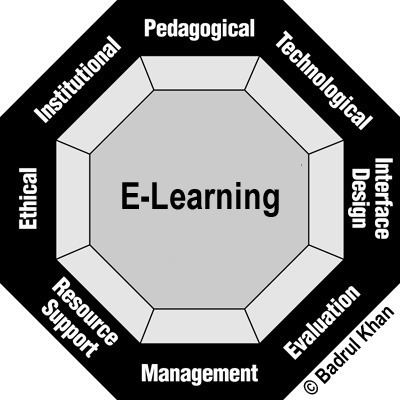 | ||
Badrul Khan's eight-dimensional e-learning framework is a detailed self-assessment instrument for institutions to organize their evaluation of educational technology (e-learning) readiness and opportunities for growth. The framework provides a structure for systematically reviewing initiatives and programs, so that desired learning outcomes are achieved. The framework is composed of eight dimensions, each reviewed by practical checklists of 50 - 70 questions. The checklist does not include a scoring system, but serves as an instrument that verifies that each area is cultivated.
Contents
Background
Public and private educational institutions, corporations and government agencies have been transferring their courses and professional development training from traditional, on site instruction to web-based instruction. The programs are systematically assessed by frameworks that guide design, development and implementation of online programs.
Several successful educational technology (e-learning) frameworks have been developed, including:
Aligning organizational training goals and plans towards a design framework can benefit the stakeholders (i.e., administrators, designers, developers, and users), as well as improve the overall success and effectiveness of the program. Existing educational technology programs hoping to streamline, modernize, or reform current practices and systems can utilize one of the aforementioned frameworks to ensure success.
Overview
Khan's framework was developed as a response to questions from readers requesting to see exemplars of effective Web-based instruction as defined in Web-Based Instruction (1997). The framework does not constitute a model because it does not prescribe a specific process for developing educational technology environments. However, it does take into consideration the design, development, delivery, and evaluation of web-based and hybrid instruction and can provide guidance in:
Dimensions
The framework consists of eight dimensions, sometimes referred to as factors. Each dimension represents a category of issues that need to be considered in order to create successful experiences. The framework offers a practical and detailed checklist to serve as a self-assessment instrument for institutions to evaluate their educational technology readiness or their opportunities for growth.
Pedagogical
The pedagogical dimension addresses issues such as content analysis, audience analysis, goal analysis, design, and methods and strategies which assess the principles and methods of instruction (i.e., teaching and learning). It addresses how the content of a course is designed; identifies the learner's needs; and how the learning objectives will be achieved. This dimension also addresses the delivery method for the course activities and the appropriateness of the online environment for achieving the learning goals of its intended audience. When strictly face-to-face or online approaches are not feasible, the pedagogical dimension addresses the issues that enable stakeholders to prescribe alternatives, including a blended learning approach that combines elements of on-site and online instruction.
Technological
The technological dimension assesses the hardware, software, and infrastructure planning. It also addresses issues pertaining to the selection of the most suitable learning management system (LMS) and communication tools (i.e., audio and video conferencing platforms) for achieving the institution's learning goals and objectives. Technical requirements such as the server capacities, bandwidth, security, backups, and other infrastructure issues are also addressed.
Interface
The interface design dimension addresses issues five sub-dimensions that pertain to the overall look and feel of an educational technology course or program: web design, content design, navigation, accessibility, and usability testing. For online learners the user interface is the first thing they see when they login to a course. The first impression students get from a course or program is often based on the site's user interface appearance and ease of use.
Evaluation
The evaluation dimension addresses the assessment of learners; evaluation of the instruction and learning environment; assessment of content development processes and of the persons involved in the design process (i.e., the planning team, design team, production team, and evaluation team); review of instructional design processes (i.e., planning, design, development and evaluation); and evaluation of e-learning at the program and institutional levels.
Management
The management dimension addresses the continuation, updating, and upkeep of the learning environment. This continuation may be used to determine whether the educational technology atmosphere is performing adequately, and whether the instruction is meeting its intent. This dimension also addresses issues of quality control, budgeting, staffing, security, and scheduling.
Resource support
The resource support dimension considers all of the technical and human resources support required to create meaningful and successful online learning environments. Examples of the support services include web-based and telephone technical support, digital libraries, online tutorials, newsletters, journals, podcasts, glossaries, FAQs, and career counseling services.
Ethical
The ethical dimension addresses issues pertaining to social and political influence, diversity, bias, the digital divide, information accessibility, etiquette, and legal issues. Legal issues include privacy, plagiarism and copyright issues.
Institutional
The institutional dimension addresses three sub-dimensions: issues of administrative affairs, academic affairs and student services related to educational technology. Administrative affairs issues relate to admissions, financial aid, registration and payment, informational technology services, graduation, and grades. Academic Affairs refers to accreditation, policy, instructional quality, faculty and support staff, and class size. Student services is a wide field that covers everything from counseling and library support to book store, internships, and alumni affairs. Before a fully online program is launched, each of the aforementioned issues must be addressed for a smooth implementation. Online students should not be required to set foot on campus to participate in or take advantage of student services.
